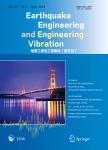Adaptive base-isolation of civil structures using variable amplification
Adaptive base-isolation of civil structures using variable amplification作者机构:Department of Civil and Environmental Engineering FAMU-FSU College of Engineering Tallahassee FL 32310 USA
出 版 物:《Earthquake Engineering and Engineering Vibration》 (地震工程与工程振动(英文刊))
年 卷 期:2006年第5卷第2期
页 面:223-233页
核心收录:
学科分类:081405[工学-防灾减灾工程及防护工程] 08[工学] 0818[工学-地质资源与地质工程] 0815[工学-水利工程] 0813[工学-建筑学] 0802[工学-机械工程] 0814[工学-土木工程] 0801[工学-力学(可授工学、理学学位)]
主 题:adaptive systems amplification base-isolation damping earthquake resistant structures multistorybuildings seismic isolation structural control
摘 要:Semi-active dampers are used in base-isolation to reduce the seismic response of civil engineering structures. In the present study, a new semi-active damping system using variable amplification will be investigated for adaptive baseisolation. It uses a novel variable amplification device (VAD) connected in series with a passive damper. The VAD is capable of producing multiple amplification factors, each corresponding to a different amplification state. Forces from the damper are amplified to the structure according to the current amplification state, which is selected via a semi-active control algorithm specifically tailored to the system's tmique damping characteristics. To demonstrate the effectiveness of the VAD-damper system for adaptive base-isolation, numerical simulations are conducted for three and seven-story base-isolated buildings subject to both far and near-field ground motions. The results indicate that the system can achieve significant reductions in response compared to the base-isolated buildings with no damper. The proposed system is also found to perform well compared to a typical semi-active damper.



